Database Backup and Disaster Planning: A Comprehensive Analysis
VerifiedAdded on 2021/10/01
|6
|1804
|153
Report
AI Summary
This report explores the critical concepts of database backup and disaster planning, comparing the two and highlighting their essential correlations. It defines database backup as a copy of the database for data recovery and disaster planning as a strategy for mitigating the impacts of potential disasters. The report categorizes database backups by data type (logical and physical) and by replication time (consistent and inconsistent). It also provides a detailed overview of disaster planning, including its objectives, the steps involved, and the importance of a disaster recovery plan. The integration of database backup within disaster planning is emphasized, especially for organizations handling significant data, and the negative impacts of failing to integrate the two are analyzed. The report concludes by stressing the importance of integrating database backup into a comprehensive disaster recovery plan to ensure effective recovery actions.
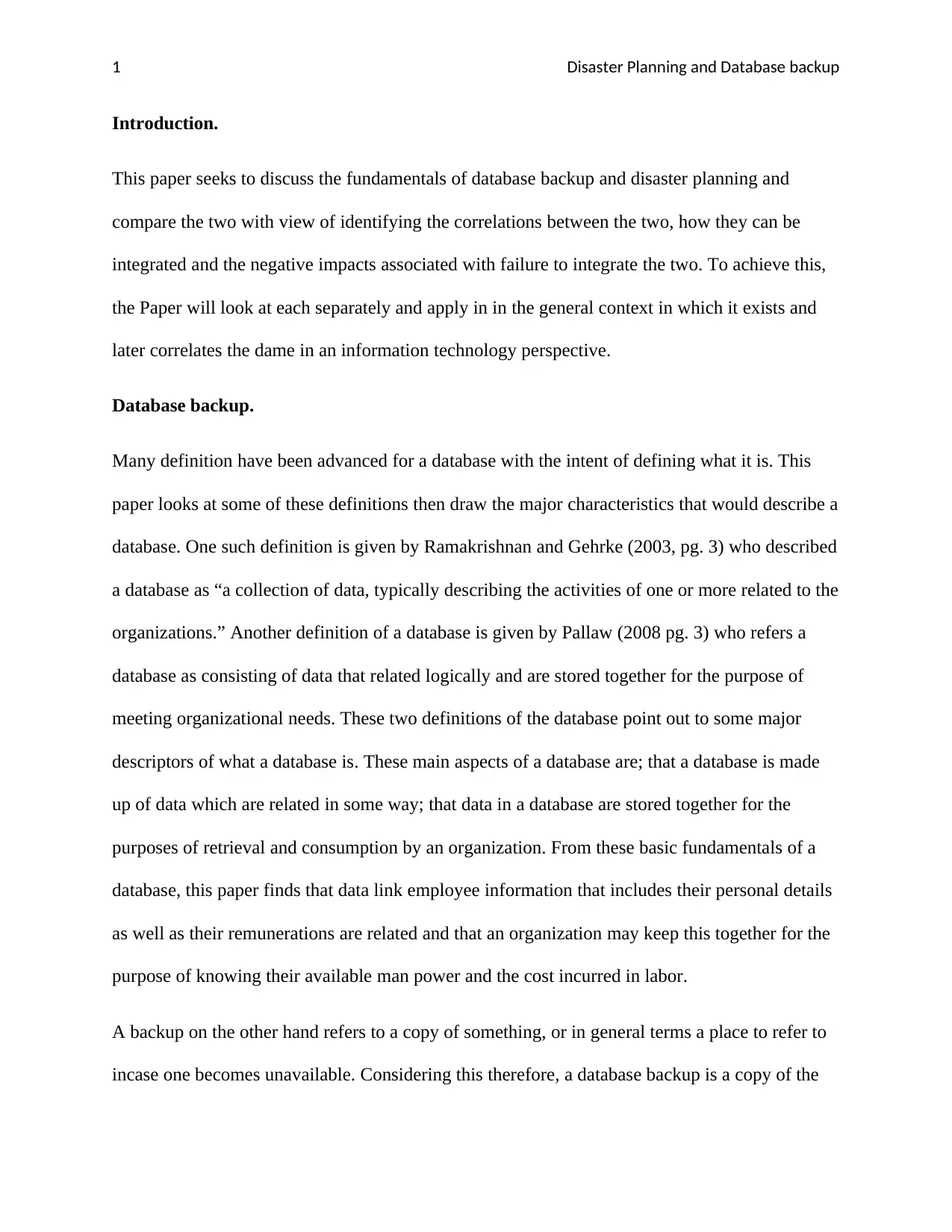
1 Disaster Planning and Database backup
Introduction.
This paper seeks to discuss the fundamentals of database backup and disaster planning and
compare the two with view of identifying the correlations between the two, how they can be
integrated and the negative impacts associated with failure to integrate the two. To achieve this,
the Paper will look at each separately and apply in in the general context in which it exists and
later correlates the dame in an information technology perspective.
Database backup.
Many definition have been advanced for a database with the intent of defining what it is. This
paper looks at some of these definitions then draw the major characteristics that would describe a
database. One such definition is given by Ramakrishnan and Gehrke (2003, pg. 3) who described
a database as “a collection of data, typically describing the activities of one or more related to the
organizations.” Another definition of a database is given by Pallaw (2008 pg. 3) who refers a
database as consisting of data that related logically and are stored together for the purpose of
meeting organizational needs. These two definitions of the database point out to some major
descriptors of what a database is. These main aspects of a database are; that a database is made
up of data which are related in some way; that data in a database are stored together for the
purposes of retrieval and consumption by an organization. From these basic fundamentals of a
database, this paper finds that data link employee information that includes their personal details
as well as their remunerations are related and that an organization may keep this together for the
purpose of knowing their available man power and the cost incurred in labor.
A backup on the other hand refers to a copy of something, or in general terms a place to refer to
incase one becomes unavailable. Considering this therefore, a database backup is a copy of the
Introduction.
This paper seeks to discuss the fundamentals of database backup and disaster planning and
compare the two with view of identifying the correlations between the two, how they can be
integrated and the negative impacts associated with failure to integrate the two. To achieve this,
the Paper will look at each separately and apply in in the general context in which it exists and
later correlates the dame in an information technology perspective.
Database backup.
Many definition have been advanced for a database with the intent of defining what it is. This
paper looks at some of these definitions then draw the major characteristics that would describe a
database. One such definition is given by Ramakrishnan and Gehrke (2003, pg. 3) who described
a database as “a collection of data, typically describing the activities of one or more related to the
organizations.” Another definition of a database is given by Pallaw (2008 pg. 3) who refers a
database as consisting of data that related logically and are stored together for the purpose of
meeting organizational needs. These two definitions of the database point out to some major
descriptors of what a database is. These main aspects of a database are; that a database is made
up of data which are related in some way; that data in a database are stored together for the
purposes of retrieval and consumption by an organization. From these basic fundamentals of a
database, this paper finds that data link employee information that includes their personal details
as well as their remunerations are related and that an organization may keep this together for the
purpose of knowing their available man power and the cost incurred in labor.
A backup on the other hand refers to a copy of something, or in general terms a place to refer to
incase one becomes unavailable. Considering this therefore, a database backup is a copy of the
Paraphrase This Document
Need a fresh take? Get an instant paraphrase of this document with our AI Paraphraser
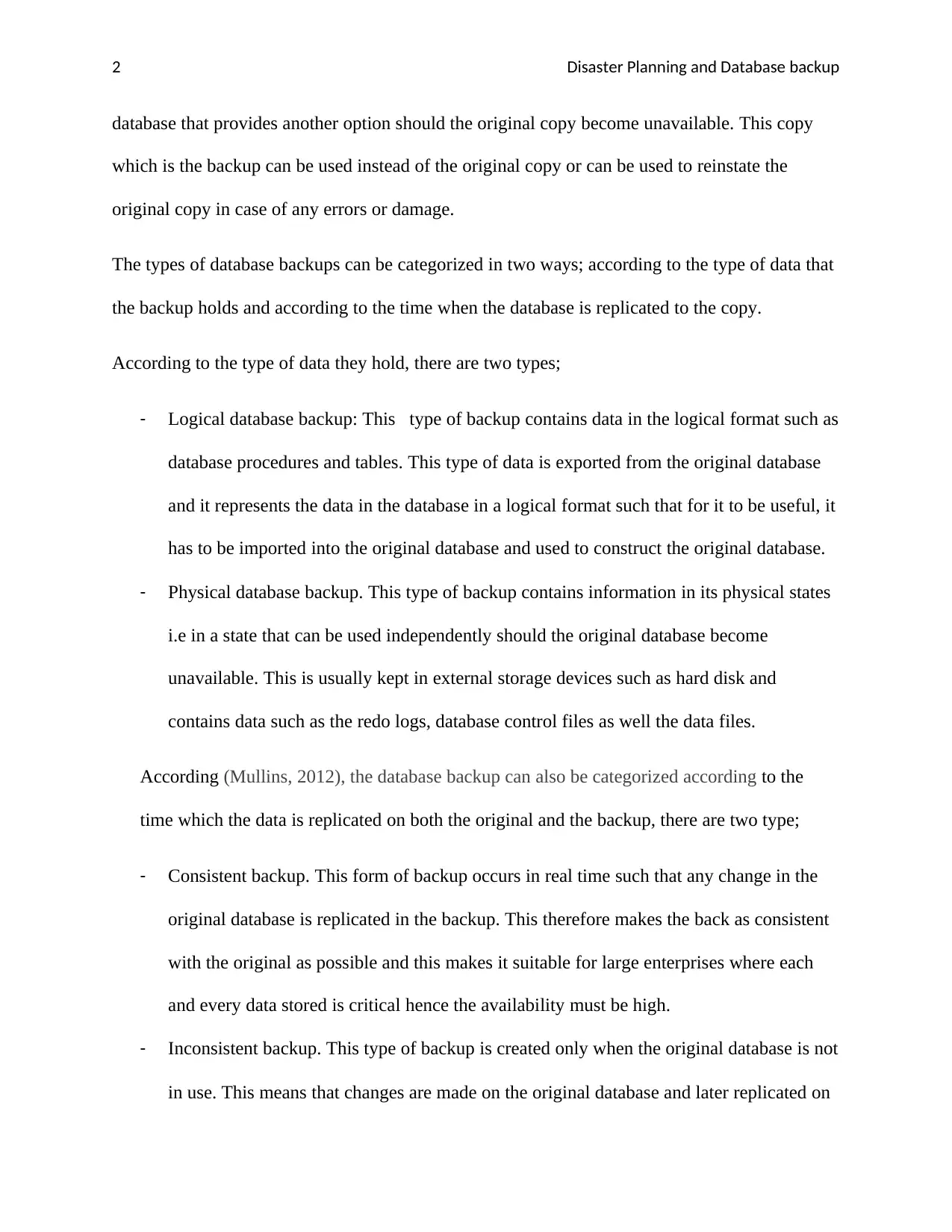
2 Disaster Planning and Database backup
database that provides another option should the original copy become unavailable. This copy
which is the backup can be used instead of the original copy or can be used to reinstate the
original copy in case of any errors or damage.
The types of database backups can be categorized in two ways; according to the type of data that
the backup holds and according to the time when the database is replicated to the copy.
According to the type of data they hold, there are two types;
- Logical database backup: This type of backup contains data in the logical format such as
database procedures and tables. This type of data is exported from the original database
and it represents the data in the database in a logical format such that for it to be useful, it
has to be imported into the original database and used to construct the original database.
- Physical database backup. This type of backup contains information in its physical states
i.e in a state that can be used independently should the original database become
unavailable. This is usually kept in external storage devices such as hard disk and
contains data such as the redo logs, database control files as well the data files.
According (Mullins, 2012), the database backup can also be categorized according to the
time which the data is replicated on both the original and the backup, there are two type;
- Consistent backup. This form of backup occurs in real time such that any change in the
original database is replicated in the backup. This therefore makes the back as consistent
with the original as possible and this makes it suitable for large enterprises where each
and every data stored is critical hence the availability must be high.
- Inconsistent backup. This type of backup is created only when the original database is not
in use. This means that changes are made on the original database and later replicated on
database that provides another option should the original copy become unavailable. This copy
which is the backup can be used instead of the original copy or can be used to reinstate the
original copy in case of any errors or damage.
The types of database backups can be categorized in two ways; according to the type of data that
the backup holds and according to the time when the database is replicated to the copy.
According to the type of data they hold, there are two types;
- Logical database backup: This type of backup contains data in the logical format such as
database procedures and tables. This type of data is exported from the original database
and it represents the data in the database in a logical format such that for it to be useful, it
has to be imported into the original database and used to construct the original database.
- Physical database backup. This type of backup contains information in its physical states
i.e in a state that can be used independently should the original database become
unavailable. This is usually kept in external storage devices such as hard disk and
contains data such as the redo logs, database control files as well the data files.
According (Mullins, 2012), the database backup can also be categorized according to the
time which the data is replicated on both the original and the backup, there are two type;
- Consistent backup. This form of backup occurs in real time such that any change in the
original database is replicated in the backup. This therefore makes the back as consistent
with the original as possible and this makes it suitable for large enterprises where each
and every data stored is critical hence the availability must be high.
- Inconsistent backup. This type of backup is created only when the original database is not
in use. This means that changes are made on the original database and later replicated on
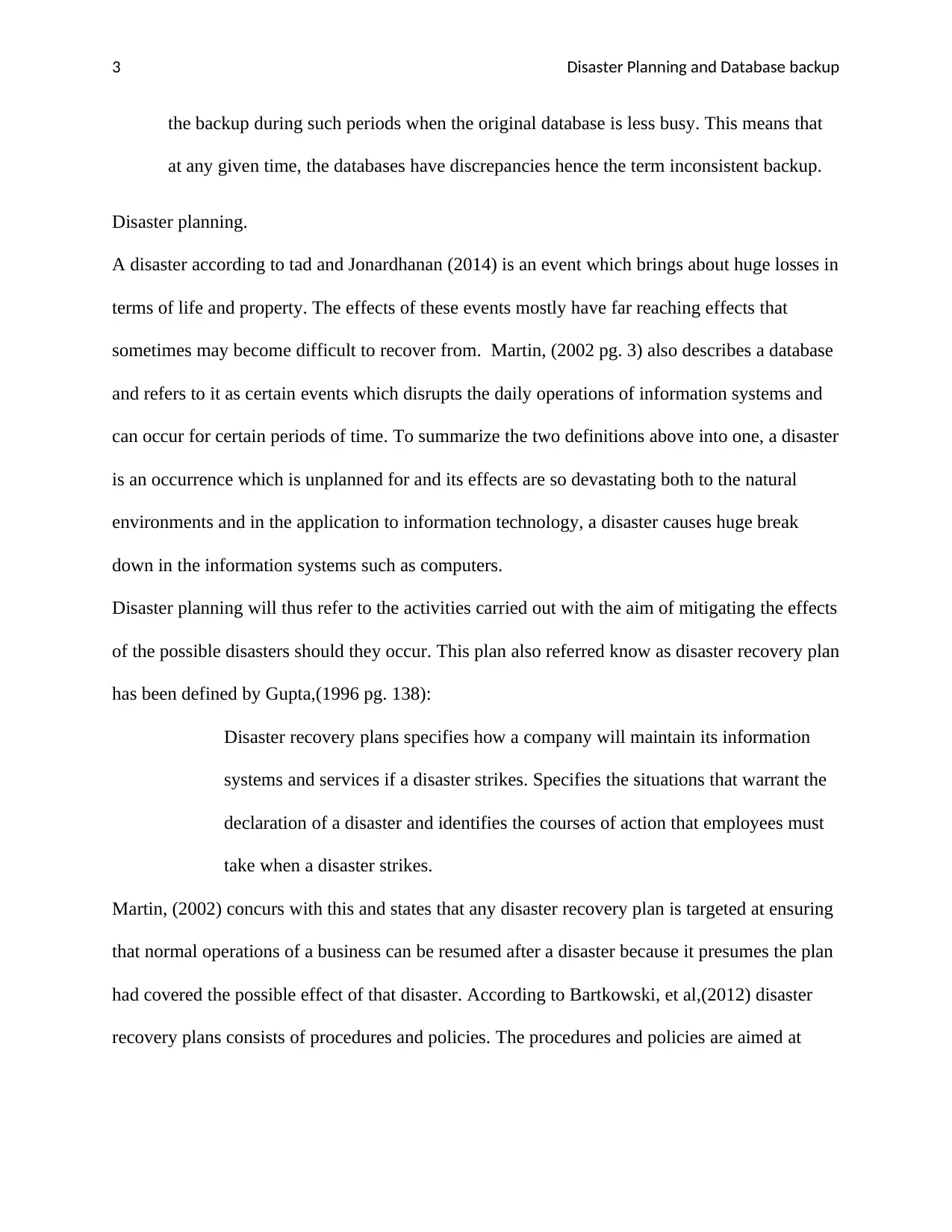
3 Disaster Planning and Database backup
the backup during such periods when the original database is less busy. This means that
at any given time, the databases have discrepancies hence the term inconsistent backup.
Disaster planning.
A disaster according to tad and Jonardhanan (2014) is an event which brings about huge losses in
terms of life and property. The effects of these events mostly have far reaching effects that
sometimes may become difficult to recover from. Martin, (2002 pg. 3) also describes a database
and refers to it as certain events which disrupts the daily operations of information systems and
can occur for certain periods of time. To summarize the two definitions above into one, a disaster
is an occurrence which is unplanned for and its effects are so devastating both to the natural
environments and in the application to information technology, a disaster causes huge break
down in the information systems such as computers.
Disaster planning will thus refer to the activities carried out with the aim of mitigating the effects
of the possible disasters should they occur. This plan also referred know as disaster recovery plan
has been defined by Gupta,(1996 pg. 138):
Disaster recovery plans specifies how a company will maintain its information
systems and services if a disaster strikes. Specifies the situations that warrant the
declaration of a disaster and identifies the courses of action that employees must
take when a disaster strikes.
Martin, (2002) concurs with this and states that any disaster recovery plan is targeted at ensuring
that normal operations of a business can be resumed after a disaster because it presumes the plan
had covered the possible effect of that disaster. According to Bartkowski, et al,(2012) disaster
recovery plans consists of procedures and policies. The procedures and policies are aimed at
the backup during such periods when the original database is less busy. This means that
at any given time, the databases have discrepancies hence the term inconsistent backup.
Disaster planning.
A disaster according to tad and Jonardhanan (2014) is an event which brings about huge losses in
terms of life and property. The effects of these events mostly have far reaching effects that
sometimes may become difficult to recover from. Martin, (2002 pg. 3) also describes a database
and refers to it as certain events which disrupts the daily operations of information systems and
can occur for certain periods of time. To summarize the two definitions above into one, a disaster
is an occurrence which is unplanned for and its effects are so devastating both to the natural
environments and in the application to information technology, a disaster causes huge break
down in the information systems such as computers.
Disaster planning will thus refer to the activities carried out with the aim of mitigating the effects
of the possible disasters should they occur. This plan also referred know as disaster recovery plan
has been defined by Gupta,(1996 pg. 138):
Disaster recovery plans specifies how a company will maintain its information
systems and services if a disaster strikes. Specifies the situations that warrant the
declaration of a disaster and identifies the courses of action that employees must
take when a disaster strikes.
Martin, (2002) concurs with this and states that any disaster recovery plan is targeted at ensuring
that normal operations of a business can be resumed after a disaster because it presumes the plan
had covered the possible effect of that disaster. According to Bartkowski, et al,(2012) disaster
recovery plans consists of procedures and policies. The procedures and policies are aimed at
⊘ This is a preview!⊘
Do you want full access?
Subscribe today to unlock all pages.

Trusted by 1+ million students worldwide
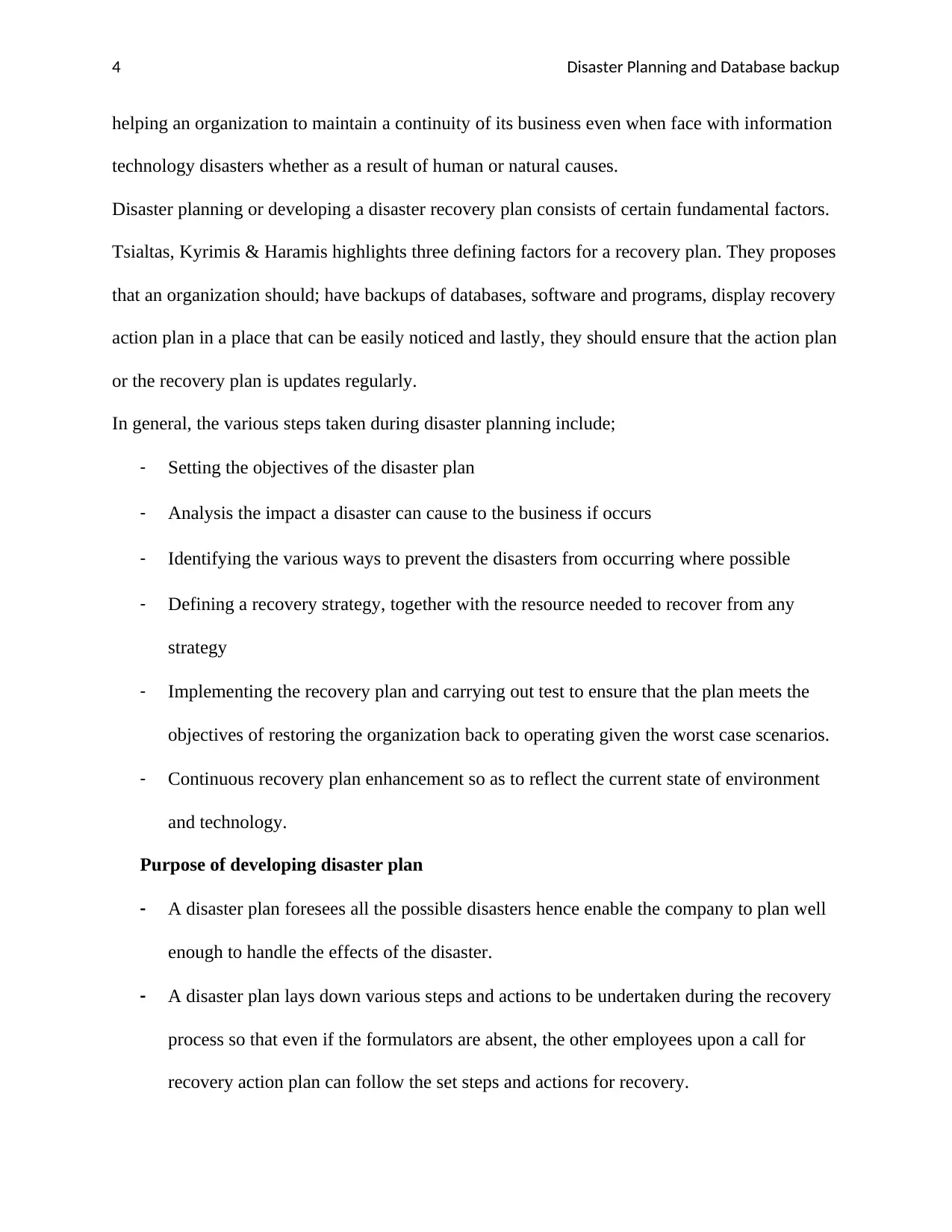
4 Disaster Planning and Database backup
helping an organization to maintain a continuity of its business even when face with information
technology disasters whether as a result of human or natural causes.
Disaster planning or developing a disaster recovery plan consists of certain fundamental factors.
Tsialtas, Kyrimis & Haramis highlights three defining factors for a recovery plan. They proposes
that an organization should; have backups of databases, software and programs, display recovery
action plan in a place that can be easily noticed and lastly, they should ensure that the action plan
or the recovery plan is updates regularly.
In general, the various steps taken during disaster planning include;
- Setting the objectives of the disaster plan
- Analysis the impact a disaster can cause to the business if occurs
- Identifying the various ways to prevent the disasters from occurring where possible
- Defining a recovery strategy, together with the resource needed to recover from any
strategy
- Implementing the recovery plan and carrying out test to ensure that the plan meets the
objectives of restoring the organization back to operating given the worst case scenarios.
- Continuous recovery plan enhancement so as to reflect the current state of environment
and technology.
Purpose of developing disaster plan
- A disaster plan foresees all the possible disasters hence enable the company to plan well
enough to handle the effects of the disaster.
- A disaster plan lays down various steps and actions to be undertaken during the recovery
process so that even if the formulators are absent, the other employees upon a call for
recovery action plan can follow the set steps and actions for recovery.
helping an organization to maintain a continuity of its business even when face with information
technology disasters whether as a result of human or natural causes.
Disaster planning or developing a disaster recovery plan consists of certain fundamental factors.
Tsialtas, Kyrimis & Haramis highlights three defining factors for a recovery plan. They proposes
that an organization should; have backups of databases, software and programs, display recovery
action plan in a place that can be easily noticed and lastly, they should ensure that the action plan
or the recovery plan is updates regularly.
In general, the various steps taken during disaster planning include;
- Setting the objectives of the disaster plan
- Analysis the impact a disaster can cause to the business if occurs
- Identifying the various ways to prevent the disasters from occurring where possible
- Defining a recovery strategy, together with the resource needed to recover from any
strategy
- Implementing the recovery plan and carrying out test to ensure that the plan meets the
objectives of restoring the organization back to operating given the worst case scenarios.
- Continuous recovery plan enhancement so as to reflect the current state of environment
and technology.
Purpose of developing disaster plan
- A disaster plan foresees all the possible disasters hence enable the company to plan well
enough to handle the effects of the disaster.
- A disaster plan lays down various steps and actions to be undertaken during the recovery
process so that even if the formulators are absent, the other employees upon a call for
recovery action plan can follow the set steps and actions for recovery.
Paraphrase This Document
Need a fresh take? Get an instant paraphrase of this document with our AI Paraphraser
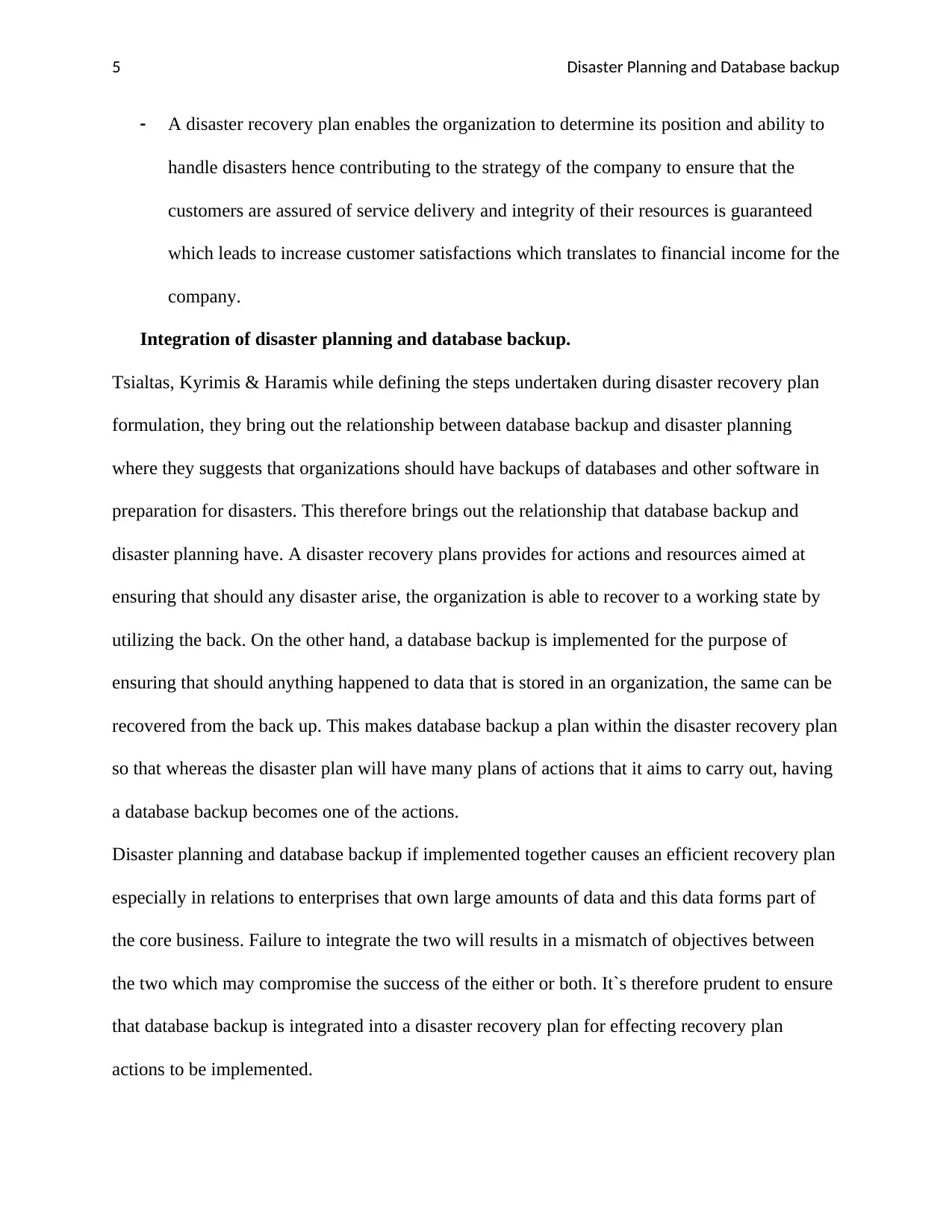
5 Disaster Planning and Database backup
- A disaster recovery plan enables the organization to determine its position and ability to
handle disasters hence contributing to the strategy of the company to ensure that the
customers are assured of service delivery and integrity of their resources is guaranteed
which leads to increase customer satisfactions which translates to financial income for the
company.
Integration of disaster planning and database backup.
Tsialtas, Kyrimis & Haramis while defining the steps undertaken during disaster recovery plan
formulation, they bring out the relationship between database backup and disaster planning
where they suggests that organizations should have backups of databases and other software in
preparation for disasters. This therefore brings out the relationship that database backup and
disaster planning have. A disaster recovery plans provides for actions and resources aimed at
ensuring that should any disaster arise, the organization is able to recover to a working state by
utilizing the back. On the other hand, a database backup is implemented for the purpose of
ensuring that should anything happened to data that is stored in an organization, the same can be
recovered from the back up. This makes database backup a plan within the disaster recovery plan
so that whereas the disaster plan will have many plans of actions that it aims to carry out, having
a database backup becomes one of the actions.
Disaster planning and database backup if implemented together causes an efficient recovery plan
especially in relations to enterprises that own large amounts of data and this data forms part of
the core business. Failure to integrate the two will results in a mismatch of objectives between
the two which may compromise the success of the either or both. It`s therefore prudent to ensure
that database backup is integrated into a disaster recovery plan for effecting recovery plan
actions to be implemented.
- A disaster recovery plan enables the organization to determine its position and ability to
handle disasters hence contributing to the strategy of the company to ensure that the
customers are assured of service delivery and integrity of their resources is guaranteed
which leads to increase customer satisfactions which translates to financial income for the
company.
Integration of disaster planning and database backup.
Tsialtas, Kyrimis & Haramis while defining the steps undertaken during disaster recovery plan
formulation, they bring out the relationship between database backup and disaster planning
where they suggests that organizations should have backups of databases and other software in
preparation for disasters. This therefore brings out the relationship that database backup and
disaster planning have. A disaster recovery plans provides for actions and resources aimed at
ensuring that should any disaster arise, the organization is able to recover to a working state by
utilizing the back. On the other hand, a database backup is implemented for the purpose of
ensuring that should anything happened to data that is stored in an organization, the same can be
recovered from the back up. This makes database backup a plan within the disaster recovery plan
so that whereas the disaster plan will have many plans of actions that it aims to carry out, having
a database backup becomes one of the actions.
Disaster planning and database backup if implemented together causes an efficient recovery plan
especially in relations to enterprises that own large amounts of data and this data forms part of
the core business. Failure to integrate the two will results in a mismatch of objectives between
the two which may compromise the success of the either or both. It`s therefore prudent to ensure
that database backup is integrated into a disaster recovery plan for effecting recovery plan
actions to be implemented.
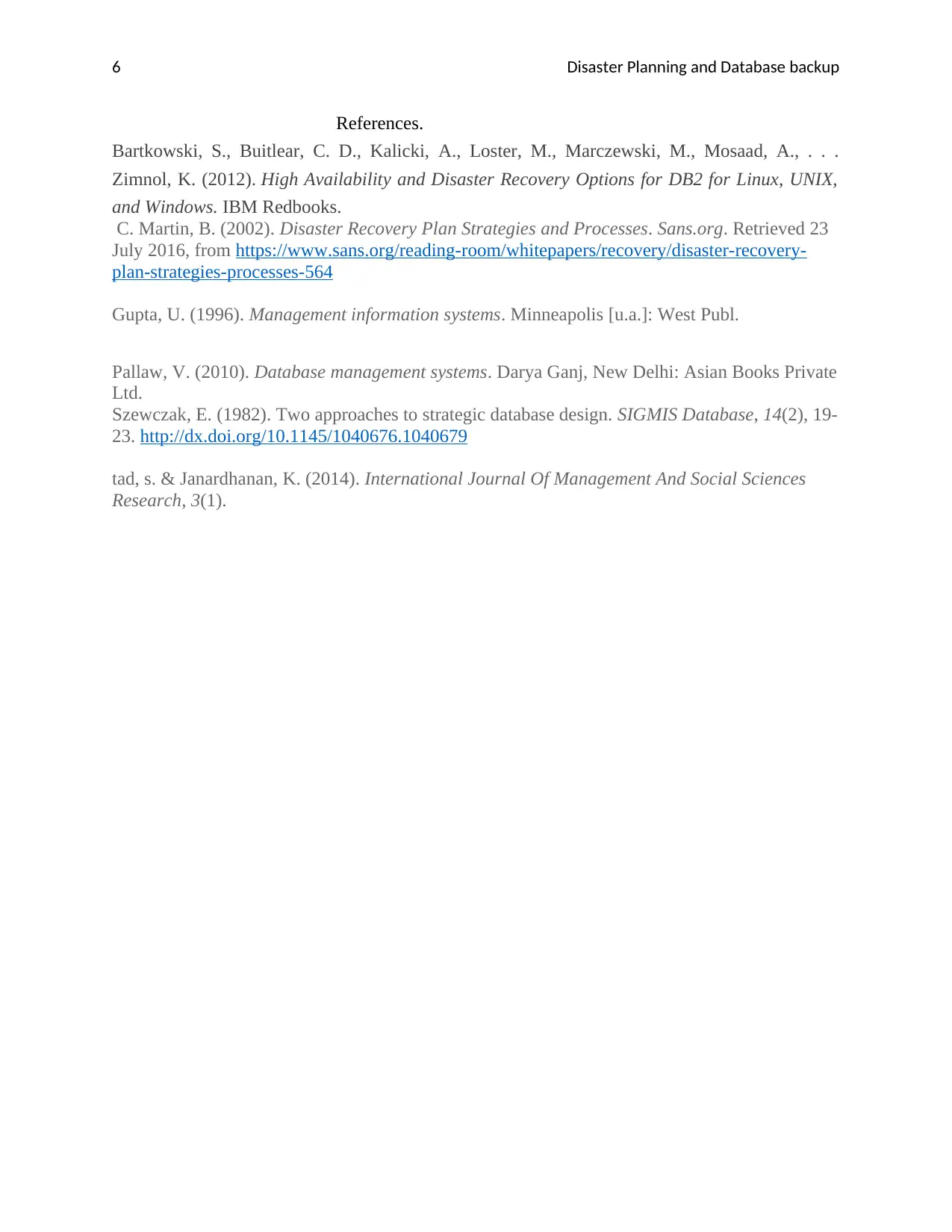
6 Disaster Planning and Database backup
References.
Bartkowski, S., Buitlear, C. D., Kalicki, A., Loster, M., Marczewski, M., Mosaad, A., . . .
Zimnol, K. (2012). High Availability and Disaster Recovery Options for DB2 for Linux, UNIX,
and Windows. IBM Redbooks.
C. Martin, B. (2002). Disaster Recovery Plan Strategies and Processes. Sans.org. Retrieved 23
July 2016, from https://www.sans.org/reading-room/whitepapers/recovery/disaster-recovery-
plan-strategies-processes-564
Gupta, U. (1996). Management information systems. Minneapolis [u.a.]: West Publ.
Pallaw, V. (2010). Database management systems. Darya Ganj, New Delhi: Asian Books Private
Ltd.
Szewczak, E. (1982). Two approaches to strategic database design. SIGMIS Database, 14(2), 19-
23. http://dx.doi.org/10.1145/1040676.1040679
tad, s. & Janardhanan, K. (2014). International Journal Of Management And Social Sciences
Research, 3(1).
References.
Bartkowski, S., Buitlear, C. D., Kalicki, A., Loster, M., Marczewski, M., Mosaad, A., . . .
Zimnol, K. (2012). High Availability and Disaster Recovery Options for DB2 for Linux, UNIX,
and Windows. IBM Redbooks.
C. Martin, B. (2002). Disaster Recovery Plan Strategies and Processes. Sans.org. Retrieved 23
July 2016, from https://www.sans.org/reading-room/whitepapers/recovery/disaster-recovery-
plan-strategies-processes-564
Gupta, U. (1996). Management information systems. Minneapolis [u.a.]: West Publ.
Pallaw, V. (2010). Database management systems. Darya Ganj, New Delhi: Asian Books Private
Ltd.
Szewczak, E. (1982). Two approaches to strategic database design. SIGMIS Database, 14(2), 19-
23. http://dx.doi.org/10.1145/1040676.1040679
tad, s. & Janardhanan, K. (2014). International Journal Of Management And Social Sciences
Research, 3(1).
⊘ This is a preview!⊘
Do you want full access?
Subscribe today to unlock all pages.

Trusted by 1+ million students worldwide
1 out of 6
Related Documents
Your All-in-One AI-Powered Toolkit for Academic Success.
+13062052269
info@desklib.com
Available 24*7 on WhatsApp / Email
![[object Object]](/_next/static/media/star-bottom.7253800d.svg)
Unlock your academic potential
Copyright © 2020–2025 A2Z Services. All Rights Reserved. Developed and managed by ZUCOL.





